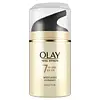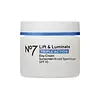Olay Total Effects 7inOne Face Moisturizer Versus No7 Lift & Luminate Triple Action Day Cream SPF 30
What's inside
What's inside
 Key Ingredients
Key Ingredients

 Benefits
Benefits

 Concerns
Concerns

 Ingredients Side-by-side
Ingredients Side-by-side

Water
Skin ConditioningGlycerin
HumectantNiacinamide
SmoothingIsohexadecane
EmollientDimethicone
EmollientIsopropyl Isostearate
EmollientStearyl Alcohol
EmollientPanthenol
Skin ConditioningTocopheryl Acetate
AntioxidantSodium Ascorbyl Phosphate
AntioxidantRetinyl Propionate
Skin ConditioningCamellia Sinensis Leaf Extract
AntimicrobialBHT
AntioxidantC13-14 Isoparaffin
EmollientCaprylyl Glycol
EmollientDimethiconol
EmollientLaureth-7
EmulsifyingCetearyl Glucoside
EmulsifyingCetearyl Alcohol
EmollientStearic Acid
CleansingPalmitic Acid
EmollientCetyl Alcohol
EmollientBehenyl Alcohol
EmollientDisodium EDTA
Polyacrylamide
PEG-100 Stearate
Titanium Dioxide
Cosmetic Colorant1,2-Hexanediol
Skin ConditioningPhenoxyethanol
PreservativeParfum
MaskingCI 19140
Cosmetic ColorantCI 16035
Cosmetic ColorantWater, Glycerin, Niacinamide, Isohexadecane, Dimethicone, Isopropyl Isostearate, Stearyl Alcohol, Panthenol, Tocopheryl Acetate, Sodium Ascorbyl Phosphate, Retinyl Propionate, Camellia Sinensis Leaf Extract, BHT, C13-14 Isoparaffin, Caprylyl Glycol, Dimethiconol, Laureth-7, Cetearyl Glucoside, Cetearyl Alcohol, Stearic Acid, Palmitic Acid, Cetyl Alcohol, Behenyl Alcohol, Disodium EDTA, Polyacrylamide, PEG-100 Stearate, Titanium Dioxide, 1,2-Hexanediol, Phenoxyethanol, Parfum, CI 19140, CI 16035
Butyl Methoxydibenzoylmethane 3%
UV AbsorberEthylhexyl Salicylate 5%
UV AbsorberOctocrylene 7.5%
UV AbsorberWater
Skin ConditioningC12-15 Alkyl Benzoate
AntimicrobialGlycerin
HumectantTribehenin
EmollientAlcohol Denat.
AntimicrobialDimethicone
EmollientButylene Glycol
HumectantAluminum Starch Octenylsuccinate
AbsorbentMica
Cosmetic ColorantCetearyl Alcohol
EmollientButyrospermum Parkii Butter
Skin ConditioningCetearyl Glucoside
EmulsifyingAmmonium Acryloyldimethyltaurate/Vp Copolymer
Phenoxyethanol
PreservativePotassium Cetyl Phosphate
EmulsifyingMethylparaben
PreservativeDimethiconol
EmollientAscorbyl Glucoside
AntioxidantParfum
MaskingPropylene Glycol
HumectantXanthan Gum
EmulsifyingEthylparaben
PreservativePentylene Glycol
Skin ConditioningSodium Hyaluronate
HumectantTocopheryl Acetate
AntioxidantHibiscus Abelmoschus Extract
MaskingRetinyl Palmitate
Skin ConditioningPhyllanthus Emblica Fruit Extract
HumectantHydrolyzed Rice Protein
Skin ConditioningTetrasodium EDTA
Sorbitan Laurate
EmulsifyingT-Butyl Alcohol
PerfumingPotassium Hydroxide
BufferingCarbomer
Emulsion StabilisingPanax Ginseng Root Extract
EmollientDipropylene Glycol
HumectantDimethylmethoxy Chromanol
AntioxidantPolysorbate 20
EmulsifyingHydroxyethylcellulose
Emulsion StabilisingAcetyl Dipeptide-1 Cetyl Ester
Skin ConditioningMorus Alba Leaf Extract
Skin ConditioningSilica
AbrasiveSodium Benzoate
MaskingTocopherol
AntioxidantPalmitoyl Tripeptide-1
Skin ConditioningPalmitoyl Tetrapeptide-7
Skin ConditioningCI 77891
Cosmetic ColorantButyl Methoxydibenzoylmethane 3%, Ethylhexyl Salicylate 5%, Octocrylene 7.5%, Water, C12-15 Alkyl Benzoate, Glycerin, Tribehenin, Alcohol Denat., Dimethicone, Butylene Glycol, Aluminum Starch Octenylsuccinate, Mica, Cetearyl Alcohol, Butyrospermum Parkii Butter, Cetearyl Glucoside, Ammonium Acryloyldimethyltaurate/Vp Copolymer, Phenoxyethanol, Potassium Cetyl Phosphate, Methylparaben, Dimethiconol, Ascorbyl Glucoside, Parfum, Propylene Glycol, Xanthan Gum, Ethylparaben, Pentylene Glycol, Sodium Hyaluronate, Tocopheryl Acetate, Hibiscus Abelmoschus Extract, Retinyl Palmitate, Phyllanthus Emblica Fruit Extract, Hydrolyzed Rice Protein, Tetrasodium EDTA, Sorbitan Laurate, T-Butyl Alcohol, Potassium Hydroxide, Carbomer, Panax Ginseng Root Extract, Dipropylene Glycol, Dimethylmethoxy Chromanol, Polysorbate 20, Hydroxyethylcellulose, Acetyl Dipeptide-1 Cetyl Ester, Morus Alba Leaf Extract, Silica, Sodium Benzoate, Tocopherol, Palmitoyl Tripeptide-1, Palmitoyl Tetrapeptide-7, CI 77891
Ingredients Explained
These ingredients are found in both products.
Ingredients higher up in an ingredient list are typically present in a larger amount.
Cetearyl alcohol is a mixture of two fatty alcohols: cetyl alcohol and stearyl alcohol. It is mainly used as an emulsifier. Emulsifiers help prevent the separation of oils and products. Due to its composition, it can also be used to thicken a product or help create foam.
Cetearyl alcohol is an emollient. Emollients help soothe and hydrate the skin by trapping moisture.
Studies show Cetearyl alcohol is non-toxic and non-irritating. The FDA allows products labeled "alcohol-free" to have fatty alcohols.
This ingredient is usually derived from plant oils such as palm, vegetable, or coconut oils. There is debate on whether this ingredient will cause acne.
Due to the fatty acid base, this ingredient may not be Malassezia folliculitis safe.
Learn more about Cetearyl AlcoholCetearyl Glucoside is a surfactant and emulsifier. It can be produced from synthetic of natural sources of cetearyl alcohol and glucose.
Emulsifiers help prevent ingredients from separating, such as oils and waters. It can also be used to enhance the texture of products.
As a surfactant, Cetearyl Glucoside helps during the cleansing process. By gathering all the dirt and oils, it allows these molecules to be washed away easily.
Learn more about Cetearyl GlucosideDimethicone is a type of synthetic silicone created from natural materials such as quartz.
What it does:
Dimethicone comes in different viscosities:
Depending on the viscosity, dimethicone has different properties.
Ingredients lists don't always show which type is used, so we recommend reaching out to the brand if you have questions about the viscosity.
This ingredient is unlikely to cause irritation because it does not get absorbed into skin. However, people with silicone allergies should be careful about using this ingredient.
Note: Dimethicone may contribute to pilling. This is because it is not oil or water soluble, so pilling may occur when layered with products. When mixed with heavy oils in a formula, the outcome is also quite greasy.
Learn more about DimethiconeDimethiconol is a silicone that resembles the popular dimethicone. Like other silicones, it is an emollient. Emollients create a thin film on skin to prevent moisture from escaping.
This ingredient helps to create a silky texture and improve spreadability. Due to its high molecular weight and thickness, it is often combined with cyclopentasiloxane.
Glycerin is already naturally found in your skin. It helps moisturize and protect your skin.
A study from 2016 found glycerin to be more effective as a humectant than AHAs and hyaluronic acid.
As a humectant, it helps the skin stay hydrated by pulling moisture to your skin. The low molecular weight of glycerin allows it to pull moisture into the deeper layers of your skin.
Hydrated skin improves your skin barrier; Your skin barrier helps protect against irritants and bacteria.
Glycerin has also been found to have antimicrobial and antiviral properties. Due to these properties, glycerin is often used in wound and burn treatments.
In cosmetics, glycerin is usually derived from plants such as soybean or palm. However, it can also be sourced from animals, such as tallow or animal fat.
This ingredient is organic, colorless, odorless, and non-toxic.
Glycerin is the name for this ingredient in American English. British English uses Glycerol/Glycerine.
Learn more about GlycerinParfum is a catch-all term for an ingredient or more that is used to give a scent to products.
Also called "fragrance", this ingredient can be a blend of hundreds of chemicals or plant oils. This means every product with "fragrance" or "parfum" in the ingredients list is a different mixture.
For instance, Habanolide is a proprietary trade name for a specific aroma chemical. When used as a fragrance ingredient in cosmetics, most aroma chemicals fall under the broad labeling category of “FRAGRANCE” or “PARFUM” according to EU and US regulations.
The term 'parfum' or 'fragrance' is not regulated in many countries. In many cases, it is up to the brand to define this term.
For instance, many brands choose to label themselves as "fragrance-free" because they are not using synthetic fragrances. However, their products may still contain ingredients such as essential oils that are considered a fragrance by INCI standards.
One example is Calendula flower extract. Calendula is an essential oil that still imparts a scent or 'fragrance'.
Depending on the blend, the ingredients in the mixture can cause allergies and sensitivities on the skin. Some ingredients that are known EU allergens include linalool and citronellol.
Parfum can also be used to mask or cover an unpleasant scent.
The bottom line is: not all fragrances/parfum/ingredients are created equally. If you are worried about fragrances, we recommend taking a closer look at an ingredient. And of course, we always recommend speaking with a professional.
Learn more about ParfumPhenoxyethanol is a preservative that has germicide, antimicrobial, and aromatic properties. Studies show that phenoxyethanol can prevent microbial growth. By itself, it has a scent that is similar to that of a rose.
It's often used in formulations along with Caprylyl Glycol to preserve the shelf life of products.
Tocopheryl Acetate is AKA Vitamin E. It is an antioxidant and protects your skin from free radicals. Free radicals damage the skin by breaking down collagen.
One study found using Tocopheryl Acetate with Vitamin C decreased the number of sunburned cells.
Tocopheryl Acetate is commonly found in both skincare and dietary supplements.
Learn more about Tocopheryl AcetateWater. It's the most common cosmetic ingredient of all. You'll usually see it at the top of ingredient lists, meaning that it makes up the largest part of the product.
So why is it so popular? Water most often acts as a solvent - this means that it helps dissolve other ingredients into the formulation.
You'll also recognize water as that liquid we all need to stay alive. If you see this, drink a glass of water. Stay hydrated!
Learn more about Water